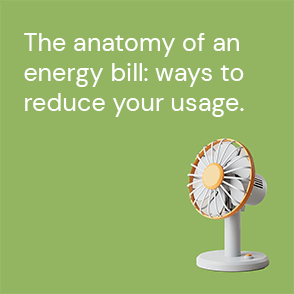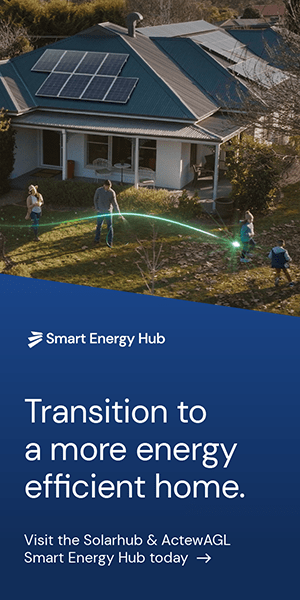ENERGY SAVINGS
The anatomy of
an energy bill:
ways to reduce
your usage.
If your household energy bill was a pie chart, how would it be sliced? If you’ve ever wondered what home functions and appliances consume the most energy in your home, here we reveal the top power-hungry culprits.
From the seemingly innocent to the surprisingly energy-intensive, let’s shed light on what might be impacting your energy bill and provide some practical tips on how to become more energy-savvy.
Heating and cooling: 40%
As every Australian knows, we really feel those four seasons. Cold winters and hot summers mean one thing: a high reliance on heating and cooling. So it comes as little surprise that heating and cooling can account for around 40% of your energy bill. Here are some practical tips to take the sting out of your energy bill.
Tip 1
In warmer months, utilise your ceiling fan to improve airflow and create a cooling effect by spinning it counter clockwise. In winter, your ceiling fan can push warmer air downwards when it spins clockwise, creating a more comfortable environment.
Tip 2
When the sun is at its peak, closing curtains and blinds during the hottest part of the day can block out sunlight and keep your home cooler in warmer months. In winter, opening curtains and blinds on sunny days will let natural heat and sunlight warm up your space.
Tip 3
Air leaks let out precious hot and cold air. Inspect your doors, windows and other openings for air leaks. Use weatherstripping or caulking to seal gaps, thus, trapping heat or cool air inside.
Appliances: 25%
From refrigerators and washing machines to TVs and entertainment systems, your appliances – big and small – account for an average of 25% of your energy bill, according to energy.gov.au. You can lower your bills with these energy-efficient tips.
Tip 1
Take time to turn it off. Many appliances continue to consume energy even on standby mode. Use a smart power strip to turn off multiple appliances at once.
Tip 2
Old, out-of-date appliances are often an energy drain. When purchasing new ones, consider choosing energy-efficient appliances with a high number of stars on the Energy Rating Label, as they will consume less electricity.
Tip 3
Stay on top of your energy usage by installing a smart meter or energy monitor. These will help your household track electricity consumption and identify areas for improvement.
Hot water: 25%
Hot water is an essential part of our daily routines. As such, its continuous demand can turn up the heat on our energy bills and the environment. Around a quarter of your monthly bill is for heating water for everyday tasks like bathing, washing dishes and laundry. These are simple yet effective changes to improve your hot water habits.
Tip 1
Switch to a low-flow shower head that restricts the water flow while maintaining perfect pressure. According to Climate Choices, you can save 14,500 litres of hot water yearly with a 3-star water-efficient showerhead.
Tip 2
Take advantage of off-peak hours to run your large, hot water-using appliances like dishwashers or washing machines. Ensure they’re fully loaded to capacity to maximise efficiency and program the timer to ping into action late evening or early morning when electricity rates are lower.
Tip 3
When upgrading your water heater, choose an energy-efficient one that serves your household needs. Electric storage water heaters are typically cheaper to buy, although they are expensive to run. Meanwhile, a solar or heat pump water heater is the opposite and will save you energy costs in the long term.
Lighting: 10%
We all love basking in the warm embrace of a well-lit home. Lighting accounts for approximately 10% of your bill, so how can we be more environmentally savvy while brightening up your space? These tips shed light on clever ways to lower your home light usage without losing an ounce of ambience.
Tip 1
Just reading a book or working on your laptop? Switch to task lighting instead. Flip the switch on your overheads when doing a single activity and use task-specific lighting like desk lamps or under-cabinet lights.
Tip 2
Be clever about how you maximise light in your home. Keep windows clear from interior obstructions, open blinds or curtains, and strategically place mirrors to bounce natural light around. Pale wall colours will brighten spaces too.
Tip 3
Ultra energy-efficient and using up to 75% less electricity than traditional incandescent bulbs is LED lighting. What’s more, they have a longer lifespan, lasting up to 25 times longer, which means fewer replacements and reduced maintenance costs-win-win!
Summary
- Heating and cooling accounts for 40% of your energy bill on average. Bring costs down by using a ceiling fan, opening and closing curtains to shield or bring warmth and sealing draughty gaps.
- Home appliances account for 25% of your energy bill on average. Save by turning them off with a smart power strip, purchasing energy-efficient appliances with a high Energy Rating Label and using a smart meter to track your usage.
- Hot water accounts for 25% of your energy bill on average. Use a low-flow showerhead, fully load your washing machine and dishwasher and switch to a solar or heat pump water heater.
- Lighting accounts for an average of 10% of your energy bill. Cut down usage by using task lighting rather than overheads, keep windows free from obstruction and switch to LEDs where possible.
ActewAGL's energy saving tips are designed to help you take control of your energy use, while reducing your bills and environmental impact. Save with great value energy plans backed by our sustainability promise, supported by 100% local, award-winning service - so you can LIVE A Good Life now and into the future.
For more information about how you can transition to an energy-efficient home visit the SolarHub & ActewAGL Smart Energy Hub today.
Sources
https://www.agl.com.au/discover/energy/4-ways-make-home-energy-efficient
https://www.yourhome.gov.au/energy
https://www.energy.gov.au/households/appliances
https://www.energyrating.gov.au/consumer-information/products/water-heating
Disclaimer: These Energy Savings tips and articles are for information purposes only. Please ensure you are aware of any safety precautions before operating appliances or products.



